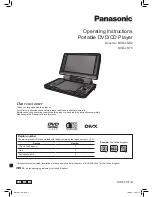
7
REV D
60706-231
LUBRICATION
Before starting the engine, fill the crankcase to the proper level with
a good quality oil. The recommended grade oil and quantity of oil
required is listed in the engine operator’s manual and under the service
tab in this manual. This unit was shipped with most of the oil removed.
The engine normally holds 78 - 80 oz (2.4 - 2.5 qts) of oil. Since there
is some trapped in the engine, when filling the crankcase the first time,
use the dipstick to ensure that you do not over fill the crankcase. The
full oil level mark on the dipstick is depicted in the following image.
Oil is added to the engine by removing the oil cap and adding oil at
this point. After filling the crankcase to the proper level, be sure you
properly tighten the oil fill cap.
NOTE: This engine generator must be on a level surface before you
check or add oil to the system.
The necessity of using the correct oil and keeping the crankcase full
cannot be overemphasized. Engine failures resulting from inadequate
or improper lubricant are considered abuse and not covered by the
generator or engine manufacturer’s warranty.
OIL RECOMMENDATIONS
Outdoor temperatures determine the proper oil viscosity for the
engines. Use the chart to select the best viscosity for the outdoor
temperature range expected.
OIL ALERT SYSTEM
This generator is equipped standard with the Briggs & Stratton low oil
pressure shutdown system. The low oil shutdown system is designed
to prevent severe damage caused by an insufficient amount of oil in
the crankcase. However, if the unit is repeatedly allowed to shutdown
on low oil pressure, progressive damage will be done to the engine,
shortening the engine’s life. The engine switch will remain in the “ON”
position when the unit is shutdown by the low oil pressure system.
CAUTION: EQUIPMENT DAMAGE
Allowing the engine to shutdown repeatedly on low oil level may cause
excessive wear which can be cumulative.
BATTERY INSTALLATION
You will need to connect this unit to a battery to operate it. Cables
have not been provided as length are going to vary depending on
your installation. These engines are all negative ground. The positive
battery cable must be connected to the open large terminal on the
start solenoid (This terminal may have a small 16 GA. wire on it for
the charging circuit). The negative cable should be attached to a good
ground on the engine. This is usually one of the starter mounting studs.
A twelve volt battery, rated at 300 CCA or larger is recommended for
this electric start generator set. Follow the battery manufacturer’s
recommendations for servicing and charging prior to use.
A 12 Volt battery, BCI group 26 rated at 500 CCA or larger is
recommended for this electric start engine-generator set. Follow the
battery manufacturers recommendations for servicing and charging
prior to use. Connect the battery to the electric start system using the
cables provided.
CAUTION: EQUIPMENT DAMAGE
These electric start engines are NEGATIVE GROUND. Use extreme
caution when connecting the battery. Connect the NEGATIVE battery
terminal to GROUND.
For your safety, always connect the positive battery cable to the “bat+”
terminal first. Then connect the negative battery cable to the “Bat-”
terminal. Make sure all connections are clean an tight. Reverse the
sequence when disconnecting, disconnect the negative cable first.
These engines produce enough direct current to keep the battery
charged under normal operating conditions, but were not intended to
be used as a battery charger.
WARNING: PERSONAL INJURY
Lead acid batteries produce explosive hydrogen gas when charging.
Keep sparks, flames, and burning cigarettes away from the battery.
Ventilate the area when charging or using the battery in an enclosed
space. Lead acid batteries contain sulfuric acid, which causes severe
burns. If acid contacts eyes, skin, or clothing, flush well with water.
For
contact with the eyes, get immediate medical attention.
BATTERY CHARGING
Units have a small flywheel charger built into the engine flywheel
assembly for recharging the starting battery. This flywheel charger
generates a small AC current that passes through a diode assembly
to produce DC charging current of about 1 to 3 Amps. This circuit is
not designed to be used as a battery charging circuit to recharge dead
batteries.


































